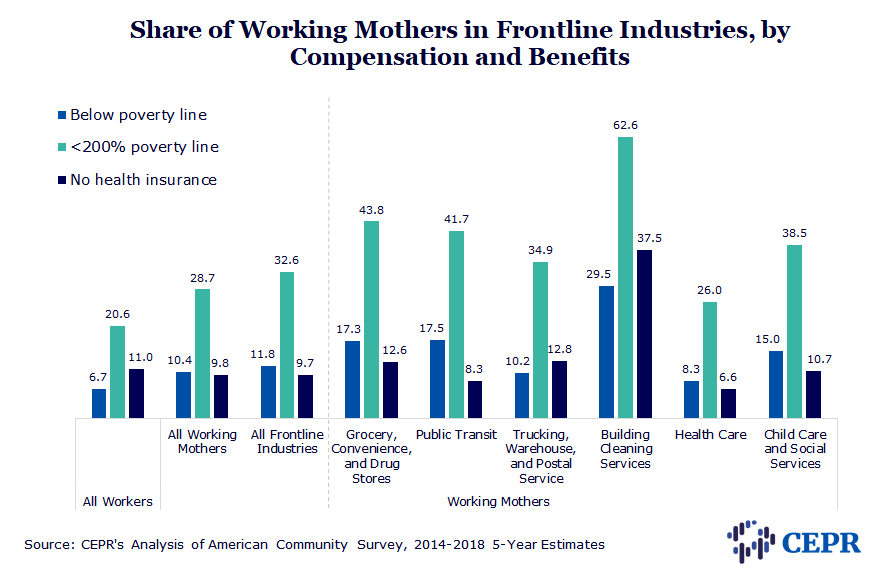May 08, 2020
Prior to the arrival of COVID-19, over 30 million workers were employed across six broad industry categories that are now on the pandemic’s frontlines.These workers include grocery store clerks, nurses and assistants, cleaners, warehouse workers, and bus drivers, among others. Over 7.5 million of them — nearly one-in-four — are also mothers caring for minor children. The share of workers in frontline industries who are mothers (23.8 percent) is larger than the share of workers in all industries who are mothers (16.9 percent).
The Table below provides information about working mothers in six frontline industry categories. Nearly a third (32.8 percent) of workers in Child Care and Social Services industries are mothers, as are over a quarter (28.8 percent) of workers in Health Care industries. Both of these frontline industry groups have seen large declines in employment in April, but we can’t say yet whether mothers are over- or underrepresented among those losing jobs.
Mothers working in frontline industries are disproportionately nonwhite compared to the general workforce, and to other mothers in the general workforce. This is especially striking in Building Cleaning Services. Though nonwhite workers are already overrepresented in this industry group, the trend is even more pronounced among mothers; over 70 percent of mothers who work in Building Cleaning Services are nonwhite, and nearly 60 percent are Hispanic. Mothers who work in Trucking, Warehouse, and Postal Service industries and Public Transit industries are also disproportionately nonwhite compared to all workers in those industry groups. In the former, 43.6 percent of all workers are nonwhite, while 51.8 percent of mothers are nonwhite. In the latter, 45.3 percent and 60.1 percent of all workers and mothers, respectively, are nonwhite. Moreover, in Public Transit, 34.2 percent of mothers are Black, compared to only 26 percent of all Public Transit workers.
Immigrants are overrepresented among working mothers in many frontline industries, including Building Cleaning Services (57 percent); Child Care and Social Services (19.4 percent); and Trucking Warehouse, and Postal Service (20.2 percent). Immigrants make up 19 percent of all working mothers and 19.6 percent of working mothers in all frontline industries combined. Unfortunately, at least some of these immigrant mothers and their children are ineligible for the one-time cash payment in the recent CARES Act, and preexisting benefits like SNAP.
| All Workers | Working Mothers | ||||||||
|---|---|---|---|---|---|---|---|---|---|
| All Working Mothers | All Frontline Industries | Grocery, Convenience, and Drug Stores | Public Transit | Trucking, Warehouse, and Postal Service | Building Cleaning Services | Health Care | Child Care and Social Services | ||
| All Workers (16+) (in thousands) | 152,600 | 25,794 | 31,673 | 6,818 | 804 | 3,129 | 1,485 | 16,104 | 3,333 |
| All Working Mothers (in thousands) | 25,794 | 25,794 | 7,546 | 1,186 | 73 | 237 | 336 | 4,637 | 1,078 |
| All Working Mothers (%) | 16.9 | 100.0 | 23.8 | 17.4 | 9.1 | 7.6 | 22.6 | 28.8 | 32.3 |
| (%) | (%) | (%) | (%) | (%) | (%) | (%) | (%) | (%) | |
| Unmarried | 47.6 | 39.2 | 41.2 | 55.7 | 49.2 | 44.9 | 49.2 | 36.2 | 42.8 |
| Ages of Children | |||||||||
| Children age <6 | 7.3 | 19.4 | 19.6 | 17.5 | 12.6 | 15.9 | 13.4 | 21.2 | 18.4 |
| Children age 6-17 | 22.0 | 63.8 | 62.0 | 65.6 | 70.7 | 66.1 | 64.9 | 60.3 | 63.0 |
| Children age <6 and age 6-17 | 6.5 | 16.8 | 18.4 | 16.9 | 16.7 | 18.0 | 21.7 | 18.5 | 18.6 |
| No children | 64.2 | n.a. | n.a. | n.a. | n.a. | n.a. | n.a. | n.a. | n.a. |
| Full/Part-time | |||||||||
| Full-time | 78.6 | 69.8 | 69.9 | 55.6 | 65.7 | 82.6 | 50.3 | 75.3 | 65.8 |
| Part-time | 21.4 | 30.2 | 30.1 | 44.4 | 34.3 | 17.4 | 49.7 | 24.7 | 34.2 |
| Race/Ethnicity | |||||||||
| White | 63.5 | 58.2 | 54.8 | 52.0 | 39.9 | 48.2 | 29.4 | 58.1 | 54.0 |
| Black | 11.9 | 13.7 | 18.0 | 16.4 | 34.2 | 21.0 | 8.5 | 18.7 | 18.0 |
| Hispanic | 16.8 | 19.7 | 19.3 | 23.5 | 21.7 | 24.7 | 59.2 | 14.5 | 21.6 |
| AAPI | 6.6 | 7.2 | 6.6 | 6.5 | 3.0 | 4.8 | 1.6 | 7.5 | 4.9 |
| Other | 1.2 | 1.2 | 1.3 | 1.5 | 1.2 | 1.3 | 1.2 | 1.2 | 1.5 |
| Foreign Born | 17.1 | 19.0 | 19.6 | 18.7 | 17.1 | 20.2 | 57.0 | 17.2 | 19.4 |
| Education Level | |||||||||
| LTHS | 9.3 | 10.4 | 8.9 | 18.4 | 9.8 | 9.5 | 37.1 | 4.4 | 9.0 |
| HS | 24.5 | 19.5 | 20.6 | 33.2 | 33.6 | 33.7 | 34.0 | 15.5 | 20.2 |
| Some college | 32.0 | 33.0 | 39.3 | 34.2 | 40.6 | 43.0 | 22.0 | 42.2 | 36.7 |
| College | 21.6 | 22.3 | 19.5 | 9.6 | 10.9 | 11.4 | 5.8 | 22.9 | 22.5 |
| Advanced | 12.6 | 14.9 | 11.8 | 4.7 | 5.2 | 2.5 | 1.1 | 15.0 | 11.7 |
| Home Ownership | 65.3 | 64.5 | 60.3 | 53.3 | 49.9 | 57.5 | 37.3 | 64.5 | 58.2 |
| Source and Notes: CEPR’s Analysis of American Community Survey, 2014-2018 5-Year Estimates | |||||||||
The Figure below shows the household income and health insurance status of mothers who work in frontline industries. Mothers working on the frontlines are much more likely to come from low-income (making less than 200 percent of the federal poverty line) families. Mothers working in frontline industries make up 32.6 percent of low-income families, compared to 28.7 percent of mothers working in all industries, and 20.6 percent of all workers. This trend holds across frontline industries, but is most pronounced in Building Cleaning Services, followed by Grocery, Convenience, and Drug Stores, and Public Transit. The latter is especially notable; among mothers working in Public Transit, 41.7 percent live in low-income families and 17.5 percent have incomes below the poverty line. By comparison,16 percent of all workers in Public Transit live in low-income families and 4.5 percent have incomes below the poverty line.

All frontline workers were essential before the pandemic hit, even as they were underpaid, under appreciated, and underprotected. Mothers on the frontlines face additional challenges, however. Many depend on the availability of affordable child care to continue working and may be especially hard-hit by mass school closures. Caring for children also incurs other additional expenses for everything from food to health care.
Unfortunately, the United States lags other high-income countries with regard to the types of benefits mothers and families need. Other rich nations provide child allowances or similar benefits to help offset the cost of caring for children, recognizing that doing so is a social value that improves society for everyone. The US is also the only one of 22 high-income nations without a permanent, national guarantee of paid leave. These and other policies are important for tackling gender gaps in the workforce and allowing children and families to thrive.
Finally, it is important to note that workers on the frontlines are risking their own health and safety, and in many cases, the health and safety of their families, to continue performing essential services on which the rest of society depends. In return, society must ensure that they are adequately protected on the job, with sufficient access to personal protective equipment and enforceable workplace safety policies. To this end, the Occupational Safety and Health Administration (OSHA) should enact a mandatory emergency temporary standard (ETS) on infectious diseases to protect all frontline workers. The US should also follow the lead of other countries, including, most recently, Canada, that have increased the pay of poorly compensated workers in essential industries.
As we reflect on and appreciate all of the contributions, both paid and unpaid, of mothers this Mother’s Day, our gift to mothers on the frontlines and mothers throughout America should be more tangible. In the next round of COVID-19 response legislation, Congress should act to expand paid leave policies and benefits, and to preserve, expand, and improve workplace safety as well as child care and early education systems. These are necessary investments in the type of infrastructure that the US will need to succeed in the future, and they are what mothers and families deserve.
Methodology
Throughout this piece, we use “mothers” to denote women caring for minor children in their homes. While we acknowledge that not all mothers are assigned-female-at-birth, the Census Bureau’s American Community Survey does not make it possible to disambiguate motherhood from those who identify as female.
Our estimates are based on data from the American Community Survey’s most recent five-year sample (2014–2018). For more information about our methodology, including industry classification, see our initial report on the demographics of frontline workers.








